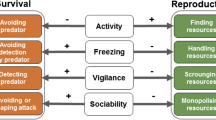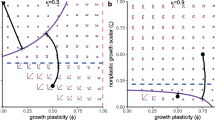Abstract
The term “hormesis” is used to describe dose–response relationships where the response is reversed between low and high doses of a stressor (generally, stimulation at low doses and inhibition at high ones). A mechanistic explanation is needed to interpret the relevance of such responses, but there does not appear to be a single universal mechanism underlying hormesis. When the endpoint is a life-history trait such as growth or reproduction, a stimulation of the response comes with costs in terms of resources. Organisms have to obey the conservation laws for mass and energy; there is no such thing as a free lunch. Based on the principles of Dynamic Energy Budget theory, we introduce three categories of explanations for hormesis that obey the conservation laws: acquisition (i.e., increasing the input of energy into the individual), allocation (i.e., rearranging the energy flows over various traits) and medication (e.g., the stressor is an essential element or acts as a cure for a disease or infection). In this discussion paper, we illustrate these explanations with cases where they might apply, and elaborate on the potential consequences for field populations.



Similar content being viewed by others
References
Alda Álvarez O, Jager T, Marco Redondo E, Kammenga JE (2006a) Physiological modes of action of toxic chemicals in the nematode Acrobeloides nanus. Environ Toxicol Chem 25:3230–3237
Alda Álvarez O, Jager T, Nuñez Coloa B, Kammenga JE (2006b) Temporal dynamics of effect concentrations. Environ Sci Technol 40:2478–2484
Baturo W, Lagadic L, Caquet T (1995) Growth, fecundity and glycogen utilization in Lymnaea palustris exposed to atrazine and hexachlorobenzene in freshwater mesocosms. Environ Toxicol Chem 14:503–511
Belz RG, Cedergreen N, Duke SO (2011) Herbicide hormesis—can it be useful in crop production? Weed Res 51:321–332
Calabrese EJ, Baldwin LA (2002) Defining hormesis. Hum Exp Toxicol 21:91–97
Calow P (1991) Physiological costs of combating chemical toxicants: ecological implications. Comp Biochem Physiol C 100:3–6
Ducrot V, Péry ARR, Lagadic L (2010) Modelling effects of diquat under realistic exposure patterns in genetically differentiated populations of the gastropod Lymnaea stagnalis. Philos Trans R Soc B 365:3485–3494
Forbes VE (2000) Is hormesis an evolutionary expectation? Funct Ecol 14:12–24
Gerhard GS (2001) Caloric restriction in nonmammalian models. J Anti-Aging Med 4:205–213
Hall SR, Becker C, Cáceres CE (2007) Parasitic castration: a perspective from a model of dynamic energy budgets. Integr Comp Biol 47:295–309
Hammers-Wirtz M, Ratte HT (2000) Offspring fitness in Daphnia: is the Daphnia reproduction test appropriate for extrapolating effects on the population level? Environ Toxicol Chem 19:1856–1866
Hansen FT, Forbes VE, Forbes TL (1999) Effects of 4-n-nonylphenol on life-history traits and population dynamics of a polychaete. Ecol Appl 9:482–495
Höss S, Weltje L (2007) Endocrine disruption in nematodes: effects and mechanisms. Ecotoxicology 16:15–28
Jager T, Klok C (2010) Extrapolating toxic effects on individuals to the population level: the role of dynamic energy budgets. Philos Trans R Soc B 365:3531–3540
Jager T, Selck H (2011) Interpreting toxicity data in a DEB framework: a case study for nonylphenol in the marine polychaete Capitella teleta. J Sea Res 66:456–462
Jager T, Crommentuijn T, Van Gestel CAM, Kooijman SALM (2004) Simultaneous modeling of multiple endpoints in life-cycle toxicity tests. Environ Sci Technol 38:2894–2900
Jager T, Vandenbrouck T, Baas J, De Coen WM, Kooijman SALM (2010) A biology-based approach for mixture toxicity of multiple endpoints over the life cycle. Ecotoxicology 19:351–361
Kendig EL, Le HH, Belcher SM (2010) Defining hormesis: evaluation of a complex concentration response phenomenon. Int J Toxicol 29:235–246
Kooijman SALM (Acc.) Waste to hurry: dynamic energy budgets explain the need of wasting to fully exploit blooming resources. Oikos (accepted for publication)
Kooijman SALM (2001) Quantitative aspects of metabolic organization: a discussion of concepts. Philos Trans R Soc B 356:331–349
Kooijman SALM, Bedaux JJM (1996) Analysis of toxicity tests on Daphnia survival and reproduction. Water Res 30:1711–1723
Mushak P (2007) Hormesis and its place in nonmonotonic dose–response relationships: some scientific reality checks. Environ Health Perspect 115:500–506
Saiz E, Movilla J, Yebra L, Barata C, Calbet A (2009) Lethal and sublethal effects of naphthalene and 1,2-dimethylnaphthalene on naupliar and adult stages of the marine cyclopoid copepod Oithona davisae. Environ Pollut 157:1219–1226
Sousa T, Domingos T, Kooijman SALM (2008) From empirical patterns to theory: a formal metabolic theory of life. Philos Trans R Soc B 363:2453–2464
Stibor H (1992) Predator induced life-history shifts in a freshwater cladoceran. Oecologia 92:162–165
Thayer KA, Melnick R, Burns K, Davis D, Huff J (2005) Fundamental flaws of hormesis for public health decisions. Environ Health Perspect 113:1271–1276
van der Schalie WH, Gentile JH (2000) Ecological risk assessment: implications of hormesis. J Appl Toxicol 20:131–139
Van Leeuwen IMM, Vera J, Wolkenhauer O (2010) Dynamic energy budget approaches for modelling organismal ageing. Philos Trans R Soc B 365:3443–3454
Weltje L, vom Saal FS, Oehlmann J (2005) Reproductive stimulation by low doses of xenoestrogens contrasts with the view of hormesis as an adaptive response. Hum Exp Toxicol 24:431–437
Winner RW, Keeling T, Yeager R, Farrell MP (1977) Effect of food type on acute and chronic toxicity of copper to Daphnia magna. Freshw Biol 7:343–349
Zimmer EI, Jager T, Ducrot V, Lagadic L, Kooijman SALM (2012) Juvenile food limitation in standardized tests—a warning to ecotoxicologists. Ecotoxicology 21:2195–2204
Zonneveld C, Kooijman SALM (1989) Application of a dynamic energy budget model to Lymnaea stagnalis (L.). Funct Ecol 3:269–278
Acknowledgments
This research has been financially supported by the European Union under the 7th Framework Programme (project acronym CREAM, contract number PITN-GA-2009-238148).
Author information
Authors and Affiliations
Corresponding author
Rights and permissions
About this article
Cite this article
Jager, T., Barsi, A. & Ducrot, V. Hormesis on life-history traits: is there such thing as a free lunch?. Ecotoxicology 22, 263–270 (2013). https://doi.org/10.1007/s10646-012-1022-0
Accepted:
Published:
Issue Date:
DOI: https://doi.org/10.1007/s10646-012-1022-0




